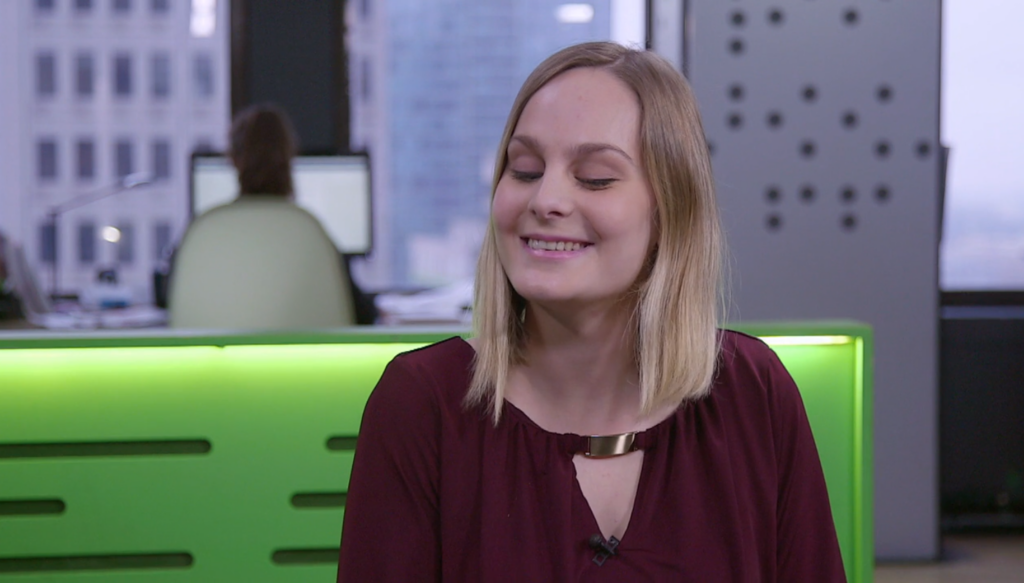Working at the Canadian National Institute for the Blind (CNIB), columnist, speaker, and inclusivity consultant Catheryne Houde is collaborating with the cinEXmedia partnership for a study exploring the connections between cinema and dreams.
Sophie Leclair-Tremblay

Columnist, speaker, and inclusivity consultant Catheryne Houde has been collaborating with cinEXmedia for over a year. At the invitation of the partnership’s director, Santiago Hidalgo, she recently agreed to join his most ambitious project to date as a co-researcher. This new research program, expected to span over several years, focuses on the relationship between cinema and dreams. It investigates most particularly how blind and visually impaired individuals dream and how they engage with cinema.
As part of the project—which has just received a grant from the Social Sciences and Humanities Research Council of Canada—data will be collected through clinical interviews to better understand how blind and visually impaired individuals experience dreaming. Researchers will assess which senses are engaged, the recurring themes of the dreams, and more. Participants will then be invited to report on their dreams, which will serve as the basis for creative-research projects (still to be defined), such as experimental short films inspired by those dream descriptions.
Catheryne Houde worked as a lawyer for several years. Today, she holds the position of Senior Manager of Inclusion, Diversity, Equity, and Accessibility at the CNIB, an organization founded over a century ago, in the aftermath of World War I, to support soldiers returning home after having lost their sight.
Recently partners with cinEXmedia, CNIB offers a wide range of services to clients of all ages. These include personalized resources—such as individual and group psychosocial support, scholarships, reading assistance kits, and legal aid—tailored to each handicaped person’s journey.
Greater Inclusion in Society
As Catheryne Houde points out, CNIB provides a valuable opportunity for blind and visually impaired individuals to connect and better integrate into society. Thanks to the organization, for instance, most children in elementary or high school grades are now being sent to their neighborhood schools instead of specialized institutions.
“That makes all the difference,” explains Houde. “The institute acts as a kind of bridge between the initial process of vision loss and the rehabilitation provided by centers offering more personalized care. These centers often have long wait times.”
CNIB also offers technological support, helping clients learn how to use smartphones and computers. “These tools are essential for blind people to complete their education and access the job market,” says Houde. “We also provide mentorship, help with writing résumés, and interview preparation. Our goal is to make them as independent as possible. For example, résumés are not written by our advisors, but by the individuals themselves. We aim to help people reach their full potential.”
The Importance of Family and Audiovisual Accessibility
The partnership with the Laboratoire CinéMédias began when Catheryne Houde joined the advisory committee for the Inclusive Media Training: Audiodescription and Videodescription program at the Université de Montréal—the first French-language university program of the kin in Canada dedicated to audiovisual media accessibility.
Having lost her sight before the age of one, Catheryne grew up in a sighted family that watched a lot of television and regularly went to the movies, at a time when videodescription was still uncommon. She was therefore always exposed to visual descriptions provided by her siblings. The rest had to be filled in by her imagination and the music, which helped her build a mental image of the film.
Today, videodescription allows her to feel less limited in her access to media content and has greatly enriched her relationship with cinema.“Your connection to cinema necessarily varies depending on when you lost your sight,” she explains. “I lost mine at eight months old, and I have no memory of that short period when I could see. Someone who becomes blind later in life draws from images they’ve already seen, from films they remember. But tools like videodescription—whose development is supported by new technologies—should definitely be made more widely available.”
For more information on media accessibility projects led by the Laboratoire CinéMédias, visit the dedicated section on our website.
